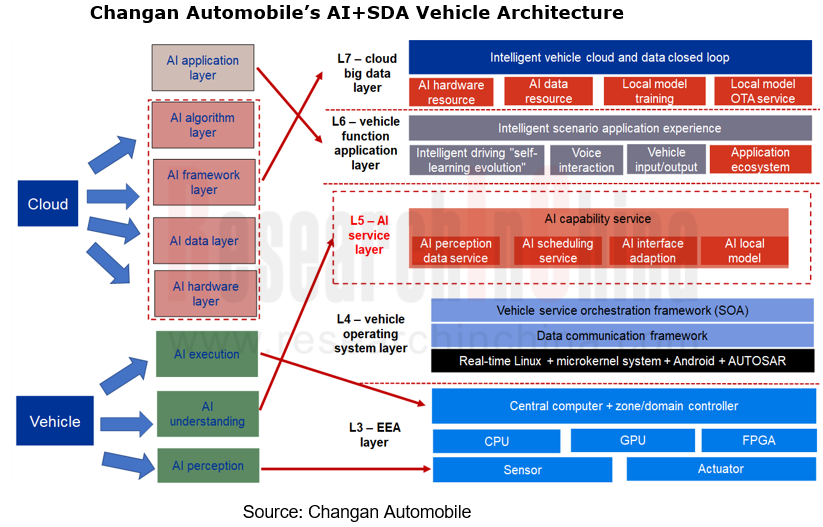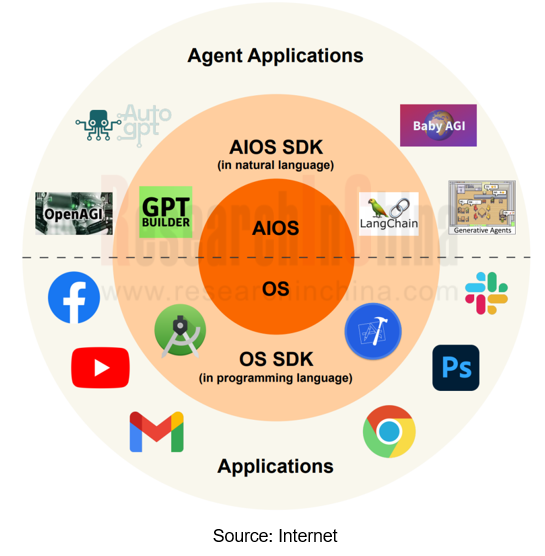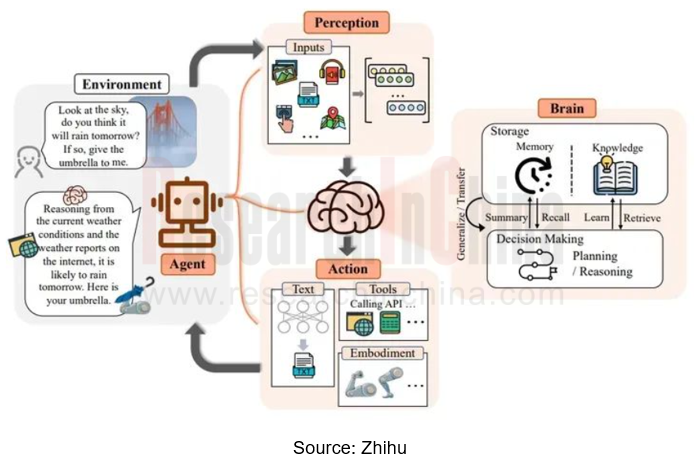AI Foundation Models’ Impacts on Vehicle Intelligent Design and Development Research Report, 2024
AI foundation models are booming. The launch of ChapGPT and SORA is shocking. Scientists and entrepreneurs at AI frontier point out that AI foundation models will rebuild all walks of life, especially tech-related fields. As a technological product, how will intelligent vehicles be changed by AI foundation models?
How foundation models will rebuild intelligent vehicles?
Following the "Automotive AI Foundation Model Technology and Application Trends Report, 2023-2024", a report which discusses impacts of AI foundation models on automotive industry from a macro perspective, ResearchInChina released the "AI Foundation Models’ Impacts on Vehicle Intelligent Design and Development Research Report, 2024", the second report which researches the impacts of AI foundation models on vehicle intelligent design and development in the such aspects as hardware, operating system, application function, and cloud big data.
In 2023, Changan Automobile added AI edge and AI service layer to the original software-driven architecture (SDA) that includes L1-L6 layers. It can be seen that AI technology has affected most layers of intelligent vehicles: L3 EEA layer, L4 vehicle OS layer, L6 vehicle function application layer (including cockpit, connectivity and intelligent driving), L7 cloud big data layer, etc. The chassis part of L1 mechanical layer and the battery part of L2 power layer have actually involved AI application.

Currently, OEMs and Tier1s apply foundation models to part of vehicle intelligence, or to some link in the development process.

When viewing the general application trend of AI foundation models in vehicles, we also need to find an idea in the evolution of foundation models. According to the results of Tencent Research Institute, AI will evolve from the brain to AI Agent, and from CoPilot to autonomous driving.
So, what is AI Agent?
Will foundation model/AI Agent replace OS/APP?
ResearchInChina accepts the view: AI foundation model is the OS, and AI Agent is the application. The development paradigm of intelligent products will be changed from conventional OS-APP ecosystem paradigm to AI foundation model-AI Agent ecosystem paradigm.

What is AI Agent? It is an artificial intelligence (AI) system beyond simple text generation. AI Agent uses a large language model (LLM) as its core computing engine, so that it can make conversations, perform tasks, make inferences, and have a degree of autonomy. In short, AI Agent is a system with complex reasoning capabilities, memory and task execution methods. It is thus clear that NOMI GPT in NIO’s cockpit and Tesla FSD V12 are AI Agents in the cockpit domain and intelligent driving domain, respectively.

AI foundation models, a platform-level AI technology, include those launched by first-tier technology companies, such as ChatGPT and ERNIE Bot. Platform-level AI can serve as the technological foundation to empower operating systems in all aspects. It is regarded as the new kernel of next-generation operating systems. The kernel of conventional operating systems is mainly responsible for managing and scheduling the system's hardware resources like GPU and memory to ensure normal operation and efficient utilization of system. Yet with increasing user demand, AI systems need to parse many human-related personalized experiences.
For personal knowledge base, people's location and status awareness, people's habits and hobbies and other personalization factors, conventional operating systems fall short of effective calculation and processing. We thus need a brand-new kernel to meet these requirements. The strength of platform-level AI foundation models is that they can manage and process multiple personal factors and help the operating system accurately recognize user intents. With such capabilities, fire-new operating systems can bring everyone an intelligent experience of “guess what you want and understand what you need.”
In automotive cockpit applications, to achieve true personalization, automakers also need to further customize the AI foundation model according to the features of their own vehicle models and services, that is, AI Agent based on platform-level AI foundation model. We can see that Geely models (such as Jiyue and Galaxy) are based on Baidu ERNIE Bot-based cockpit systems, and Mercedes-Benz's in-car voice assistant are actually an AI Agent after being connected to ChatGPT.
At present, intelligent driving AI Agent and cockpit AI Agent are separate. As cockpit-driving integration develops, they will tend to be integrated. However when considering cockpit-driving integration, OEMs and Tier1s cannot only consider integration at the hardware level, but also need to take into account operating system and vehicle system architecture, especially rapid evolution of foundation models/AI Agent models.
Foundation model/AI Agent is currently a part of an operating system/APP ecosystem. Will it replace operating systems/APP models in the future? We think it's possible.
Foundation model-based agents will not only allow everyone to have an exclusive intelligent assistant with enhanced capabilities, but also change the mode of human-machine cooperation and bring broader human-machine fusion. There are three human-AI cooperation modes: Embedding, Copilot, and Agent.
In intelligent driving, the Embedding mode is equivalent to L1-L2 autonomous driving; the Copilot mode, L2.5 and highway NOA; the Agent mode, urban NOA and L3 autonomous driving.
In the Agent mode, humans set goals and provide necessary resources (e.g., computing power), then AI independently undertakes most of tasks, and finally humans supervise the process and evaluate the final results. In this mode, AI fully embodies the interactive, autonomous and adaptable characteristics of Agents and is close to an independent actor, while humans play more of a supervisor and evaluator role.
A large number of interactive operations that were originally enabled via IVI APP can now be achieved through natural interactions (voice, gesture, etc.) in the AI Agent mode. AI Agent even actively observes the inside and outside of the vehicle, makes a request inquiry, and can perform a task after being confirmed by the user.
Therefore, the development of AI Agent is bound to make a mass of previous apps unnecessary and will have a disruptive impact on the development and application of intelligent cockpit and intelligent driving.
The current AI foundation models are not an operating system, but a paradigm and architecture of AI models, focusing on how to enable machines to process multimodal data (text, image, video, etc.). AI Agent is more similar to an AI application or application layer, which requires the support of the underlying operating system and hardware for operation. It is not in itself responsible for the basic management and resource scheduling of the computer system. In the future, AI foundation models are likely to be combined with OS to become AIOS.
AI foundation models and AI Agent development have the following impacts on future operating systems:
Applets will disappear or evolve into AI Agent that calls foundation models;
OS may evolve into the foundation model + computing chip core cluster OS architecture;
AI foundation models as a platform redefine and empower all kinds of industrial application scenarios, and give rise to more human-computer interaction-centric native applications, including autonomous vehicles, robots and digital twin applications.
Integrated Battery (CTP, CTB, CTC, and CTV)and Battery Innovation Technology Report 2025
Power battery research: 17 vehicle models use integrated batteries, and 34 battery innovation technologies are released
ResearchInChina released Integrated Battery (CTP, CTB, CTC, and CTV)and Battery...
AI/AR Glasses Industry Research Report, 2025
ResearchInChina released the " AI/AR Glasses Industry Research Report, 2025", which deeply explores the field of AI smart glasses, sorts out product R&D and ecological layout of leading domestic a...
Global and China Passenger Car T-Box Market Report 2025
T-Box Research: T-Box will achieve functional upgrades given the demand from CVIS and end-to-end autonomous driving
ResearchInChina released the "Global and China Passenger Car T-Box Market Report 20...
Automotive Microcontroller Unit (MCU) Industry Report, 2025
Research on automotive MCUs: the independent, controllable supply chain for automotive MCUs is rapidly maturing
Mid-to-high-end MCUs for intelligent vehicle control are a key focus of domestic produc...
Automotive LiDAR Industry Report, 2024-2025
In early 2025, BYD's "Eye of God" Intelligent Driving and Changan Automobile's Tianshu Intelligent Driving sparked a wave of mass intelligent driving, making the democratization of intelligent driving...
Software-Defined Vehicles in 2025: SOA and Middleware Industry Research Report
Research on automotive SOA and middleware: Development towards global SOA, cross-domain communication middleware, AI middleware, etc.
With the implementation of centrally integrated EEAs, OEM softwar...
Global and Chinese OEMs’ Modular and Common Technology Platform Research Report, 2025
Modular platforms and common technology platforms of OEMs are at the core of current technological innovation in automotive industry, aiming to enhance R&D efficiency, reduce costs, and accelerate...
Research Report on the Application of AI in Automotive Cockpits, 2025
Cockpit AI Application Research: From "Usable" to "User-Friendly," from "Deep Interaction" to "Self-Evolution"
From the early 2000s, when voice recognition and facial monitoring functions were first ...
Analysis on Li Auto’s Layout in Electrification, Connectivity, Intelligence and Sharing, 2024-2025
Mind GPT: The "super brain" of automotive AI Li Xiang regards Mind GPT as the core of Li Auto’s AI strategy. As of January 2025, Mind GPT had undergone multip...
Automotive High-precision Positioning Research Report, 2025
High-precision positioning research: IMU develops towards "domain controller integration" and "software/hardware integrated service integration"
According to ResearchInChina, in 2024, the penetration...
China Passenger Car Digital Chassis Research Report, 2025
Digital chassis research: Local OEMs accelerate chassis digitization and AI
1. What is the “digital chassis”?
Previously, we mostly talked about concepts such as traditional chassis, ch...
Automotive Micromotor and Motion Mechanism Industry Report, 2025
Automotive Micromotor and Motion Mechanism Research: More automotive micromotors and motion mechanisms are used in a single vehicle, especially in cockpits, autonomous driving and other scenarios.
Au...
Research Report on AI Foundation Models and Their Applications in Automotive Field, 2024-2025
Research on AI foundation models and automotive applications: reasoning, cost reduction, and explainability
Reasoning capabilities drive up the performance of foundation models.
Since the second ha...
China's New Passenger Cars and Suppliers' Characteristics Research Report, 2024-2025
Trends of new cars and suppliers in 2024-2025: New in-vehicle displays are installed, promising trend of AI and cars is coming
ResearchInChina releases the China's New Passenger Cars and Suppli...
Global and China Skateboard Chassis Industry Report, 2024-2025
Skateboard chassis research: already used in 8 production models, and larger-scale production expected beyond 2025
Global and China Skateboard Chassis Industry Report, 2024-2025 released by ResearchI...
Two-wheeler Intelligence and Industry Chain Research Report, 2024-2025
Research on the two-wheeler intelligence: OEMs flock to enter the market, and the two-wheeler intelligence continues to improve
This report focuses on the upgrade of two-wheeler intelligence, analyz...
Automotive MEMS (Micro Electromechanical System) Sensor Research Report, 2025
Automotive MEMS Research: A single vehicle packs 100+ MEMS sensors, and the pace of product innovation and localization are becoming much faster.
MEMS (Micro Electromechanical System) is a micro devi...
Intelligent Vehicle Cockpit-driving Integration (Cockpit-driving-parking) Industry Report, 2024-2025
Cockpit-driving integration is gaining momentum, and single-chip solutions are on the horizon
The Intelligent Vehicle Cockpit-driving Integration (Cockpit-driving-parking) Industry Repor...